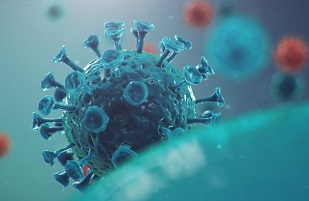Study Finds That SARS-CoV-2 ORF3A Interacts With The Clic-Like Chloride Channel-1 (CLCC1) And Triggers An Unfolded Protein Response!
COVID-19 News- ORF3A - Clic-Like Chloride Channel-1 (CLCC1) Apr 11, 2023 2 years, 8 months, 2 weeks, 4 days, 1 hour, 59 minutes ago
COVID-19 News: The ongoing battle against COVID-19 has led scientists to explore various aspects of SARS-CoV-2, the virus responsible for the disease. A deeper understanding of the interactions between the virus and the host's cellular machinery may provide novel therapeutic targets to mitigate the global impact of this pandemic.

While much attention including studies and
COVID-19 News reports have been devoted to the interaction between the viral spike protein and the host ACE2 and TMPRSS2 proteins, the accessory proteins of SARS-CoV-2 are also crucial for its pathogenesis.
This study by researchers from the University of California -San Francisco - USA focuses on the interaction between the SARS-CoV-2 ORF3A accessory protein and the host CLIC-like chloride channel-1 (CLCC1) and their role in triggering the unfolded protein response (UPR).
The Significance of ORF3A and CLCC1 in SARS-CoV-2 Pathogenesis
SARS-CoV-2 ORF3A is a 3-pass transmembrane protein, which shares 73% identity with SARS-CoV ORF3A. The deletion of ORF3A in SARS-CoV leads to reduced cytotoxicity without affecting viral replication. Similarly, ORF3A expression alone induces Golgi fragmentation, the UPR, NLRP3 inflammasome activation, and cell death. SARS-CoV-2 ORF3A also induces cell death, and its deletion from the virus significantly reduces pathogenicity in human ACE2 transgenic mice.
ORF3A interacts with a wide variety of host proteins and processes, affecting cell death pathways and immune response mechanisms. High throughput protein interaction studies identified CLCC1 as an ORF3A interacting protein. CLCC1 is a putative chloride channel predominantly localized to the endoplasmic reticulum (ER). Mutations in CLCC1 in mice and humans lead to ER stress and cell death in the cerebellum and retinal cells, respectively.
Exploring the Functional Link between ORF3A and CLCC1
Considering the role of ORF3A in inducing the UPR and CLCC1's involvement in ER stress, researchers investigated a functional link between these proteins. The physical interaction between ORF3A and CLCC1 was confirmed, and it was observed that ORF3A expression induced a homeostatic UPR, similar to CLCC1 silencing. This suggests that ORF3A may trigger the UPR through CLCC1, potentially playing a role in SARS-CoV-2-induced cytotoxicity.
The impact of CLCC1 on ORF3A-induced cell toxicity and the upregulation of UPR genes was analyzed, but the exact molecular mechanism of their interaction remains elusive. One possibility is that ORF3A inactivates CLCC1, leading to ER stress and cell death. However, CLCC1 knockdown did not increase cell death, and chemical chaperone TUDCA relieved cell death due to ORF3A expression. Another possibility is that ORF3A's cation channel activity influences CLCC1 function or directly triggers an inflammatory response. However, the role of SARS-CoV-2 ORF3A as an ion channel is still emerging.
A more plausible model suggests that ORF3A inactivation of CLCC1 triggers a homeostatic UPR instead of increasing cell death. In this model, CLCC1 knockdown might reduce ORF3A toxicity by increasing the protective homeostatic UPR response. On the other hand, CLCC1 o
verexpression could overcome CLCC1 inactivation by ORF3A, preventing the homeostatic UPR typically caused by potential CLCC1 suppression.
In this scenario, overexpression of CLCC1 would result in increased cell death. Functional CLCC1 appears to be essential for the synergy with ORF3A, as evidenced by the differential effects of wild-type and mutant CLCC1 overexpression. Nevertheless, without further binding studies and reciprocal mutations, it is difficult to determine the precise nature of the interaction between CLCC1 and ORF3A or their involvement in the UPR.
ORF3A is known to interact with numerous other host proteins besides CLCC1. One noteworthy candidate is heme oxygenase-1 (HMOX1), which typically serves to reduce oxidative stress. Data suggests that ORF3A interferes with HMOX1's role in the oxidative stress response, providing another potential avenue for therapeutic intervention.
Cell Type Specificity and Contextual Limitations
Interestingly, the impact of CLCC1 depletion seems to vary depending on the cell type. While CLCC1 silencing did not cause cell death in 293T cells, it led to cell death in retinal and cerebellar cells, presumably due to a terminal UPR. This discrepancy may arise from differences in susceptibility to ER stress-induced cell death between cell types. Therefore, the interaction between ORF3A and CLCC1 may have different outcomes depending on the specific cell type infected with SARS-CoV-2.
Additionally, differences in ORF3A localization to endosomes between various studies might be attributed to the level of ORF3A overexpression or the specific cell types used.
It is crucial to consider that this study was conducted in vitro using a recombinant expression system, and thus, its findings should be interpreted within this context. Moreover, the investigation focused on ORF3A function in isolation, without considering the effects of viral infection.
Conclusion
In conclusion, the interaction between SARS-CoV-2 ORF3A and host CLCC1 appears to activate an UPR and may functionally influence one another. Modulation of CLCC1 activity and the UPR might help reduce cytotoxicity resulting from ORF3A expression in the context of SARS-CoV-2 infection. Further research into the precise molecular mechanisms underlying the interaction between ORF3A and CLCC1, as well as the roles of other interacting host proteins, will be crucial to developing novel therapeutic strategies against COVID-19.
The study findings were published in the peer reviewed journal: Biochemistry, Biophysics And Molecular Biology.
https://peerj.com/articles/15077/
For the latest
COVID-19 News, keep on logging to Thailand Medical News.
